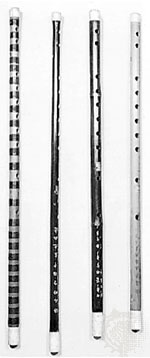di
musical instrument
Wade-Giles romanization ti also called dizi
 in music, transverse (or side-blown) bamboo flute of the Han Chinese. Traditional di have a membrane of bamboo or reed tissue covering the hole that is located between the mouth hole and the six finger holes. This membrane creates a distinctive sound characteristic of much Chinese flute music. An additional two or more end holes aid in the expulsion of air and are sometimes used to attach decorative silk tassles. Di have a two-octave range, and complete modern sets can be purchased in Western tunings. There are many varieties of traditional lengths and construction.
in music, transverse (or side-blown) bamboo flute of the Han Chinese. Traditional di have a membrane of bamboo or reed tissue covering the hole that is located between the mouth hole and the six finger holes. This membrane creates a distinctive sound characteristic of much Chinese flute music. An additional two or more end holes aid in the expulsion of air and are sometimes used to attach decorative silk tassles. Di have a two-octave range, and complete modern sets can be purchased in Western tunings. There are many varieties of traditional lengths and construction.Di probably date from roughly the 5th century BC, though some form of transverse flute is believed to have existed as early as the 9th century BC. The name once applied to end-blown (xiao) flutes as well but is now used exclusively for transverse flutes. There are two major types of di: the qu di, so named because it is used to accompany kunqu, a form of southern Chinese opera, and bang di, so named because it is used to accompany bangzixi, a form of northern opera. The qu di is about 2 ft (about 60 cm) long, and the bang di a bit over 1 ft (40 cm).
- Zürich ware
- Zürich Zoological Garden
- Zāhedān
- Zāskār Range
- zāwiyah
- Zāwiyah, Al-
- Zāwiyat al-Bayḍāʾ
- Zīrid Dynasty
- Álava
- Álava y Esquivel, Miguel Ricardo de
- Álvarez Bravo, Manuel
- Álvarez, Juan
- Álvarez Quintero brothers
- Álvar Núñez Cabeza de Vaca
- Álvaro de Bazán, Marqués de Santa Cruz
- Álvaro de Bazán Santa Cruz, Marqués de
- Álvaro de Luna
- Álvaro Fernandes
- Álvaro Mutis
- Álvaro Obregón
- Ángel de, duque de Rivas Saavedra
- Ángel de Saavedra, duque de Rivas
- Ángeles, Victoria de los
- Ángel Ganivet y García
- Ángel Guimerá